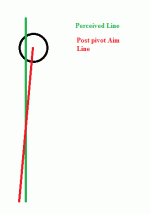The challenge: Get a group of 4 or 5 and go to Stan. He will teach them CTE. You show them where the system is wrong, and show them your method of aiming. Let the students decide if what Stan teaches is correct.
After that, you are free to set up shots, curtain or no curtain and test Stan on the system. He also is free to test you on your system. You simply have to show Stan where he is wrong, and where you can connect to the table in a better fashion.
Here's your response Colin: "Because Stan's challenge requires proof to change his mind about claims that have no basis that can be analyzed."
Now, how can you say his challenge provides nothing that can be analyzed?? You are free to analyze any part of the system!! Your statement makes no sense at all.
You say you spent years studying pivots. Yet, you failed to see the obvious? How is that possible??
Your claim about the 1/2 tip pivot is weak at best, ridiculous at worst. Prone to error? What part of pool is not prone to error? Because a person is somehow not capable of moving their tip 1/2 tip distance, that is a problem with the system??
Visual perceptions- if you really believe that statement you made, there is your challenge to Stan. Have at it.
2x1, 90 degrees- Your statements are worded as fact, not questions. They are belittling, and false. And you guys wonder how the "wars" start. They stem from a total lack of knowledge on your part. Then you go on to say you never said it doesn't work. Yet, as pointed out above, you did say just that. You state things as fact, then to cover your butt, you say you are just questioning because you don't understand. Everyone sees right through that nonsense, Colin. You wouldn't be stating things as fact if you were just trying to understand.
People keep asking how the CTE wars always happen? Look no further than your, English, and Sean's posts. Stating false things as fact and then trying to disguise your wrongful, hurtful statements as just questions. Someone else in this thread only has questions. His are being answered just fine. He's actually trying to learn it, not see what he can nitpick to knock it.
As to your last statement, not one user of it has admitted to intuitive adjustments. Another false claim by you. Then you claim someone admitted to using the rails for reference. I DID. You act like that is counter to the system. It's not, it has been said all along, you have to have visual intelligence and perspective. You cannot possibly attain that without any rails to give you a reference. So, quit acting like that is something wrong with the system. The only thing wrong is your understanding of it. The claims you guys are coming up for what 's wrong with the system are absolutely ridiculous. All they do is showcase your lack of knowledge.
